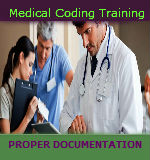There are multiple medical coding training opportunities online and in the classroom for coders and healthcare providers to learn proper documentation as ICD-10-CM quickly descends upon us. Two websites that offer excellent training are www.cco.us and www.aapc.com; however, insurance carriers and other educational websites offer trainings as well.
For many providers, detailed information is par for the course; but for others, a new mindset must be adopted, and the sooner the better. Doctors who use two line sentences to describe an encounter have no choice but to get into the habit of describing their services and procedures accurately “now”. It will be easier for them to transition to ICD-10-CM if they start at this moment and the bonus will be, not having their coders querying them every second for better information. Lastly, reimbursement counts for everything, so if they do not follow the rules, their practice will ultimately suffer.
Medical Coding Training – Proper Documentation
So let’s begin with some examples of appropriate documentation. The information required is so basic that it amazes me when I audit providers who lack the discipline.
DO NOT WRITE: Repaired wound on arm.
DO INDICATE: A laceration repair, the location, and the length such as 30.0 cm. Was it a simple repair – single layer, no debridement or intermediate repair, which are deeper layers or a single layer with debridement, or complex repair that involves significant debridement or undermining and possible reconstructive surgery such as Z-plasty.
DO NOT WRITE: Patient seen today for her asthma.
DO INDICATE: If asthma is mild intermittent, mild persistent, moderate persistent or severe persistent. How often are the attacks? Twice a week? With moderate activity? Is the visit acute, a follow-up, or educational? Is there tobacco exposure?
DO NOT WRITE: Patient came in with sore throat, a rapid strep performed. Diagnosis: Probable strep throat. Although signs and symptoms begin the process of diagnosing a patient, if a confirmed diagnosis is obtained, use the confirmed diagnosis which include the signs and symptoms the patient presented with.
DO INDICATE: The history of a fever or measured temperature greater than 100.4 ° F. Is there a cough? Are the anterior cervical nodes tender? Is there tonsillar swelling or exudates? Diagnostic considerations should be indicated. For example, if a teenager has posterior cervical adenopathy, mononucleosis might be the cause. A headache, stiff neck, and petechial rash might indicate meningitis. If a patient was in contact with someone with the past two weeks and the duration of their sore throat is less than three days, the doctor might consider strep throat. If, however, there are findings of a palatine petechiae or scarlatiniform rash, the probability of strep is greater. Was a rapid strep test done or a mono spot test? Were antibiotics prescribed? Lastly, after all the above has been documented, the final diagnosis code, if confirmed, should be listed, such as confirmed strep throat, (never use the term probable in a physician’s office. Use signs and symptoms only if no definitive diagnosis is established.
Basically, each encounter should be documented with enough information that the claim tells a complete story and coders and payers will not return the claim for lack of explicit detail.
![[CCO] Certification Coaching Organization LLC [CCO] Certification Coaching Organization LLC](https://www.cco.us/wp-content/uploads/2015/05/CCO-Logo-2015-d3-500px.png)
